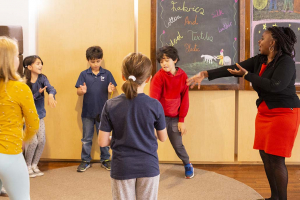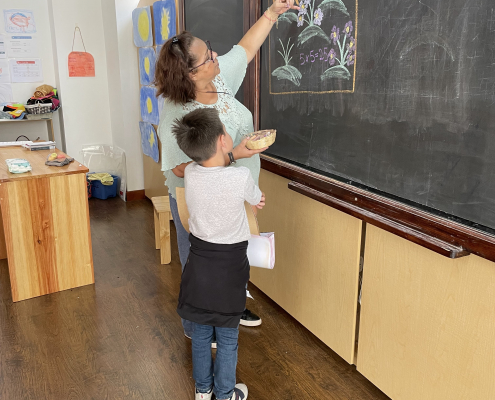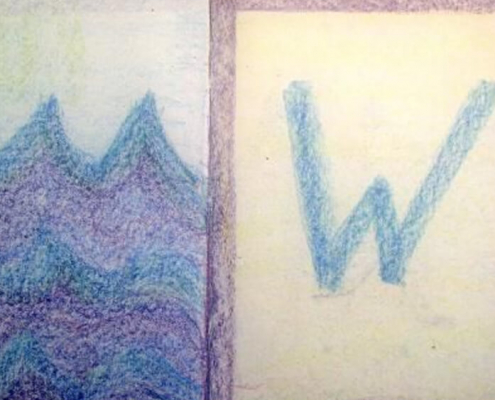To gain a comprehensive picture of Waldorf Education as Trinus provides, we must look at some aspects of this teaching method as there are:
Class educator – stays with the class ideally all through the grades, establishing good habits, providing guidance and boundaries. He is the loving authority in the lower grades and becomes the mentor in higher grades. The work of the class teacher ends with grade eight. In the high school only specialists of their subject are teaching the young adults.
Main-lesson – the center of teaching is in the morning from 8 -10 am.
- Verses, songs, plays, circle-work, movement, mental math
- Recall of previous material and also new material is introduced
- Individual working – bookwork
- Story (in the lower grades)
Teaching in blocks – teach subjects such as writing and arithmetic in main-lesson blocks of 3-4 weeks duration.
Rhythmical learning – provides a healthy balance between:
Concentration – Relaxation
Mental work – Practical work
Movement – Rest
Listening/Looking – Participation/Doing
Teaching the arts – music, painting, drawing as to strengthen imagination, intuition and inspiration.
Curriculum – the Waldorf curriculum is based on the child’s development providing the right nutrition for specific stages of their growth and addresses the whole child with their head, heart and hand.
Grade One
- Introduction to Letters through Fairy Tales
- Nature Stories
- Math: quality of numbers, whole numbers, counting to 144, the four processes using numbers 0-24, symbols of four processes, subtraction facts to 20, multiplication tables, 2x, 3x, 10; using rhythm as much as possible.
Grade Two
- Fables: Aesop’s, Celtic and others
- Legends of Saints
- Local Folklore or Native American Tales
- Math: times tables through12, number patterns, column adding, situation problems, time, money.
Grade Three
- Old Testament stories or Creation stories
- Native Americans
- Homes and Shelters
- House Building
- Clothing, Fabric and Fiber
- Farming and Food
- Math: carrying and borrowing, times table practice, long division, number patterns, weights & measures, telling time, money calculations.
Grade Four
- Human Being and Animal
- Norse Myths
- Local Geography
- Grammar
- Math: review operations, times tables, averages, long division, factoring, proofs, word problems, mental math.
Grade Five
- Ancient History: India, Persia, China, Egypt, Greece
- Botany
- Central American Geography
- Math: decimals, fractions, mixed numbers, reciprocals, metric system, map references, simple laws and patterns in math.
Grade Six
- History: Fall of Troy through Roman History; Medieval History
- Geography of the World
- Physics
- Geology and Mineralogy
- Astronomy
- Math: percentage, ratio, proportion, profit & loss, simple interest, algebraic equations, geometric drawing with ruler & compass, string designs, visual discovery of geometric patterns.
Grade Seven
- History and Literature: the Age of Exploration and Discovery, the Renaissance 1400-1700; Arthurian Legends, Biographies, Poetry
- Geography of the World: Africa, Europe, weather and map reading, geographical terms.
- Physics
- Chemistry of Combustion
- Astronomy
- Health and Nutrition
- Math: geometry, perspective drawing, business math, graphing, roots and powers.
Grade Eight
- History and Literature: 1700 to present – Industrial Revolution, colonialism, American History including life of people and biography: Shakespeare, Napoleon, Washington, Jefferson, Lincoln, inventors.
Literature: short story, elements of a story, writing a short story, Shakespeare play. - Physics
- Chemistry
- Physiology
- Geography of the World: continents (integrate with history)
- Math: practical math, set theory, percent, equations, solid geometry, volumes of solids.








